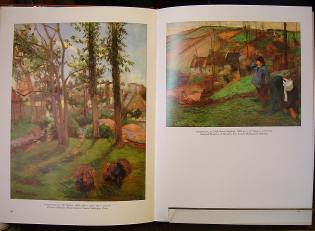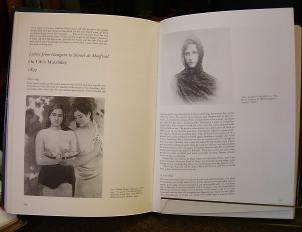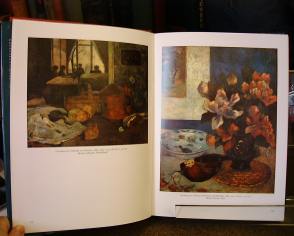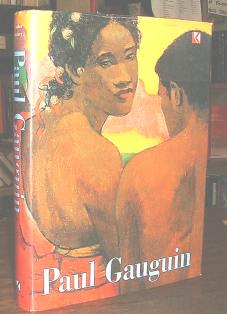INTRODUCTION
Although Paul Gauguin's
controversial art career was relatively short, in just
thirty years he created highly original masterpieces in a
wide range of styles and mediums. Starting with his own
unique version of Impressionist painting, he quickly
moved on to a powerful, rather crude form of wood
sculpture, to wildly unorthodox and fantastical ceramic
objects, to Cloissonist painting, with its firm outlines,
to Synthetist painting, with its broadly generalized
forms, to Symbolist painting, with its mysterious
contrasts. His evolution reflects his rapacious
intellect, which absorbed the stylistic principles of a
wide variety of art traditions: folk art, caricature,
medieval sculpture and stained glass, Japanese
printmaking and decorative arts, Persian manuscripts and
textiles. Far Eastern sculpture, and the so-called
primitive arts of the South Seas. Yet he seldom lost
sight of the full range of Old Master conventions,
epitomized for him by such diverse models as Botticelli,
Holbein, Rembrandt, Quentin de la Tour, Delacroix, and
Ingres. His eclecticism was apparently motivated by the
desire to create a timeless, universal art language that
could express, in addition to the physical facts of the
visible world, the invisible emotional verities of
thought, dream, and superstition.
Despite this rich complexity.
Gauguin's extraordinary life has always intrigued his
admirers at least as much as his art, and sometimes more.
Global in scope, his life was shaped by noble, if
heartless and often unnecessary, gestures of
self-righteous sacrifice and defiance for the sake of
art. No less willing to hurt others than himself to
fulfill his destiny as an artist, Gauguin abandoned a
business career and a wife and five children, and he
manipulated friends and colleagues relentlessly, as he
sought freedom from mundane responsibilities that
interfered with his single-minded passion. Boasting of
what he described as his half-savage temperament, Gauguin
sought attention and admiration by posing as a restless
maverick, always ready to accept poverty and suffering as
he turned heel to escape compromise, leaving Paris for
Rouen, Rouen for Copenhagen, Copenhagen for Brittany,
Brittany for Martinique, and so on, until death overtook
him on the remote South Pacific island of Hivaoa in 1903.
Of course, in the final analysis it is debatable whether
Gauguin's peregrinations bought time for his art or lost
it, but his unorthodox pilgrimage did startle and
polarize the avant-garde art community in France. The
purpose of this anthology of writings by the artist, his
colleagues, and his adversaries is to enable modern
readers to reconsider how the legend surrounding Gauguin
came into being. Chosen for the revelations they present
about the events in Gauguin's life and his principal
theories about art, the majority of these selections
first appeared before his death or shortly afterwards-
Taken as a whole, they amount to a fascinating case study
of how some modern artists have been able to obtain
respect and understanding by manipulating public opinion.
Apparently modeling himself on the outspoken James
McNeill Whistler, who dared to speak out for his artistic
views rather than rely exclusively on journalists and
historians, Gauguin actively promoted his own cause by
writing throughout his career, thus contributing to a
trend that has continued with our own century's
self-styled artist-celebrities, such as Max Ernst, Marcel
Duchamp, Salvador Dali, or Andy Warhol. In a letter to
Maurice Denis in 1895, Gauguin congratulated his young
disciple for writing art criticism: "... it pleases
me to see painters take care of their own interests. . .
For some time, most of all since [I formulated] my
project to bury myself in the islands of the Pacific, I
have felt this obligation with which young painters are
imposed, to write about art topics in a reasonable
fashion."
Beginning in the summer of 1890, after Gauguin had
decided to set off for Tahiti, he badgered such
colleagues as Emile Bernard, Meyer de Haan, Camille
Pissarro. and Charles Morice to use their influence with
critics who were in a position to champion his works.
Judging from the extensive essay that, by early 1891,
Octave Mirbeau agreed to write, Gauguin himself must have
dictated his colorful life in detail to the journalist,
even while insisting that he welcomed obscurity, out of
distrust for publicity. Mirbeau's highly romanticized
account, reprinted as the preface to the catalogue for a
fund-raising auction of Gauguin's works on 23 February
1891, subsequently influenced all of the artist's
biographers, who tended to explore the same issues. In
addition to Mirbeau, G.-Albert Aurier, a poet and critic
dedicated to the new Symbolist movement in literature,
agreed to write an extended explanation of Gauguin's
work; this, too, became a touchstone for future authors.
Signed on 9 February but not published until March,
slightly too late to arouse interest in the auction,
Aurier's analysis, with its detailed discussion of The
Vision after the Sermon, articulates the theoretical
tenets of Gauguin's art so comprehensively that, as with
Mirbeau's essay, it seems that the artist must have
helped to write the text. The parallels between Aurier's
own ideas about Symbolist literature and Gauguin's art
theories cannot by themselves account for Aurier's
decision to stress certain, special issues. In
particular, the passion of Aurier's conclusion, in which
he proclaims that Gauguin should become a great mural
painter, suggests that the artist himself or one of his
closest associates must have supplied information, for
otherwise Aurier, who claimed that his own personal
acquaintance wich Gauguin was strictly limited, could
hardly have guessed that Gauguin aspired to such a
career. However, as editor-in-chief of-Le Moderniste, the
polemical and influential little periodical in which
Gauguin made his debut as a critic, Aurier should have
been aware of the artist's on-again, off-again ambition
to write art criticism himself. Writers' genes were in
Gauguin's blood. His maternal grandmother, Flora Tristan,
a pioneering feminist and utopi-anist, published a novel,
her memoirs, and several sociological texts; his father
was a radical political journalist by trade. The first
evidence of Gauguin's desire to write about art is
contained in a letter to his mentor, Camille Pissarro,
written Just after the appearance ofJoris-Karl Huys-mans'
1883 article in L'Art Moderne, which included the first
detailed discussion to be published of any of Gauguin's
works. Disappointed with Huysmans' critical premises,
Gauguin confided, "If only I were a man of letters!
I should like to do this—there is something to be
done here." By 1885, Gauguin had begun to draft
theoretical texts in the spirit of the writings of Eugene
Delacroix, whose ideas about color intrigued Gauguin no
less than they intrigued his chief rival, Georges Seurat.
The present anthology includes the earliest of these
drafts, entitled "Synthetic Notes," as well as
the curious text about painting, alleged to have been
written by one Vehbi Mani Zunbul-Zadi, that Gauguin
showed to Seurat around this time. Since no source for
this translation in the spirit of 1001 Nights has yet
come to light, it has been suggested instead that Gauguin
may have composed it in the spirit of a fanciful literary
forgery.
As the already cited letter from Gauguin to Denis makes
clear, however, the former's serious efforts as a writer
began around 1891, when he first sought exile in Tahiti.
Three important texts by Gauguin must have been started
at least as rough drafts by the time he returned to
France two years later, although it is uncertain exactly
when Gauguin neatly copied them into albums that,
illustrated with watercolors, are reminiscent to some
extent of picture books for children and, moreover, of
illuminated medieval or Persian manuscripts. It is not
known whether Gauguin intended to profit from the
publication of all these texts as printed books or
expensive facsimile editions. His direct source of
inspiration for the visual format seems to have been
Delacroix's magnificent album of notes and watercolors
describing his visit to North Africa and Spain in 1832-
This elaborate notebook was obtained by the Louvre in
1891, and Gauguin may have seen it either before his
departure in June of that year or during his return visit
to France from 1893 to 1895.The first of Gauguin's
illuminated manuscripts to have been completed was
probably Ancien Culte Mahorie, a poetical account of
native Tahitian religious beliefs. Adapted, and even
plagiarized in parts, from an ambitious, early
ethnographical study published in 1837 by Jacques-Antoine
Moerenhout, this rambling gospel of exotic paganism has
since served specialists as a subtext to the symbolism of
Gauguin's early Tahitian paintings and sculptures, though
it contains no information about modern Tahiti or what
Gauguin did there. What was evidently Gauguin's second
illuminated book, inscribed 1893 on the cover and
en-tided Cahier pour Aline in honor of his only daughter,
is for the most part an anthology of short texts by
Gauguin's favorite authors, including Edgar Allan Poe,
Richard Wagner, and Paul Verlaine. But this manuscript
does include several anecdotes from Gauguin's previous
travels, as well as an exegesis of one of his most
important 1892 paintings, Manao Tu-papau. As if to
contrast his own self-critical text in Cahier pour Aline
with the efforts of professional journalists, Gauguin
subsequently clipped all the newspaper reviews of his
November 1893 exhibition in Pans and pasted them onto the
blank pages of this same notebook.
The genesis of Noa Noa, Gauguin's most important literary
account of his first trip to Tahiti, is too complicated
to detail here, but it too was probably begun before his
return to France at the end of August 1893. In October of
the same year Gauguin explained in a letter to his wife
that he was busy with this book, which begins in
diaristic fashion with Gauguin's arrival in Papeete, the
capital, and goes on to describe the phases of his
acclimatization to the Tahitian way of life that inspired
him as an artist. As has often been pointed out, the
ending of Noa Noa, with Gauguin's young Tahitian
concubine watching his ship depart, so closely recalls
the conclusion of a well-known book by Pierre Loti, Le
Manage de Loti (1882), that Gauguin's motivation to write
Noa Noa can be presumed to have been at least partly
financial. But that Noa Noa is foremost a highly
romanticized autobiography indicates that Gauguin was
most of all determined to create his own legend with this
book. Comci-demally, between 1893 and 1895 Delacroix's
Journal was published.
Although Gauguin had prepared a suite of ten magnificent
woodblock prints to illustrate Noa Noa, these were not
included when the text was ultimately published in 1897.
The delay was mostly the result of Gauguin's decision to
take advantage of the editorial skills of Morice, who
offered to supplement the artist's own commentaries with
poems as well as short sections of prose. Gauguin later
claimed that he had been Pleased at first with the notion
that in such a collaborative undertaking his own
unpolished prose would seem "primitive" in
contrast to Morice's more refined contributions. Morice
felt at liberty to change Gauguin's texts, however, and
diminished the intended contrast. Gauguin's
"primitive" version is preserved only in an
early draft of Noa Noa that was not published until 1954.
But since the elaborately illustrated manuscript version
of Noa Noa that Gauguin completed after his return to
Tahiti corresponds rather closely to the text edited by
Morice and published in 1897, it seems that Gauguin must
have accepted the poet's changes. We have therefore
included excerpts from this version, upon which the
earliest biographers of Gauguin based their accounts of
his life in Tahiti. The intentionally modern,
stream-of-consciousness style that Gauguin preferred when
he began Noa Noa is exemplified by the autobiographical
fragments that he entitled "Natures mortes" and
"Sous deux Latitudes" when he published them in
a little art magazine in 1893 and 1894. Compared with
Gauguin's spontaneously written letters, some of which
are also included here, such accounts for the press were
quite obviously literary exercises for him.
Every later witness account of his years in France
between the trips to Tahiti indicates that Gauguin
entertained liberally, holding court in his unorthodox
studio full of South Seas exotica, and that he paraded
through Paris and Brittany in unconventional outfits
designed to attract attention. It may have been his
overextended schedule that prevented Gauguin from
publishing any sequels to "Natures mortes" and
"Sous deux Latitudes." But no matter how busy,
he hardly neglected the public relations campaign that
preceded his final departure from France. His most
brilliant idea was to invite the controversial Swedish
playwright, August Strindberg, to write an introduction
for the catalogue of a second fund-raising auction on 18
February 1895. After Strindberg replied with a thoughtful
letter to decline this proposition, Gauguin went ahead
and used the letter, along with his own reply to the
unwilling supporter, as the sale catalogue's preface. A
few months later he arranged an interview to state his
case in the press one more time- The full extent to which
Gauguin influenced journalists will never be known, but
it is suggestive that by June 1895 his former friend
Bernard had already issued a public challenge to the
accuracy of the accounts written by Julien Leclercq, one
of Gauguin's most dedicated acolytes. Such efforts to
achieve notoriety and financial security before returning
to the South Seas fell far short of success. His auction
raised very little. No less optimistic that fame and
fortune would catch up with him in the months ahead than
he was that Noa Noa would soon be published, Gauguin left
his unsold works of art with dealers and friends he
entitled to accept offers. His letters back to France
record the collapse of this optimism, aggravated by his
failing health and constant poverty. Already by the
summer of 1896 he was openly discussing the possibility
of suicide. When he was too unwell or depressed to make
art, he turned again to writing, making additions to his
manuscript copy of Noa Noa and compiling a miscellany of
other reminiscences and opinions which he entitled
Diverses Choses (Miscellaneous Thoughts). At this time he
also began a lengthy, tendentious, and turgid book,
L'Esprit moderne et Ie Ca-tholicisme (The Modern Spirit
and Catholicism), about the shortcomings and
contradictions of Christian theology. Putting all these
texts aside at the end of 1897, however, he threw himself
into one last monumental painting designed as a
comprehensive testament to his world view: Where Do We
Come From? Who Are We? Where Are We Going? This was a
prelude to his suicide attempt in January 1898, the only
record of which, of course, is the letter describing his
failure to his most trusted correspondent, Daniel de
Monfreid.
Embittered by his inability to exert meaningful control
over his fortunes in France, Gauguin involved himself in
local politics and, following in his father's footsteps,
became a contributor to a monthly anti-administration
newsletter entitled Les Guepes (The Wasps).6
Enjoying his new spoiler's role and the notoriety it
brought him, in 1898 he went so far as to begin his own
little four-page monthly pamphlet, a broadside entitled
Le Sourire {The Smile}. Although these political articles
shed considerable light on Gauguin's disenchanted
personality, since they do not concern his art career, we
have chosen to omit them here, preferring to focus
instead upon the growth of his legend back in France.
Reacting to the news of his suicide attempt, his
supporters there renewed their efforts to bring his art
to the public's attention by organizing an exhibition in
Paris at the end of 1898 with Where Do We Come From? as
the centerpiece.
When Gauguin received copies of the press reviews of this
exhibition, he immediately recovered his drive to assert
his critical beliefs and entered into correspondence with
the critic of Mercure de France, Andre Fontainas, whom he
had never met. Eventually Gauguin appointed this stranger
as his literary agent, sending him in September 1902 a
rambling text entitled Racontars de Rapin (Tales of a
Young Painter) with the hope that Mercure de France would
publish it. When it was refused, Gauguin, undeterred,
sent Fontainas a long book in manuscript, full of
disconnected anecdotes about his childhood, his
tumultuous friendship with Van Gogh, his trials in the
South Seas, and his ultimate opinions on criticism and
aesthetics- Based in part on Diverses Choses, this final
autobiography, which he entitled Avant. et Apres (Before
and After), amounts to a sequel to Noa Noa, and he urged
Fontainas to find a publisher.
Meanwhile, probably without Gauguin's knowledge, his
former colleague Armand Seguin began to publish three
important articles about the artist, whose works by now
were in such demand that the murals he had painted at an
inn in Brittany in 1889 had now been removed by
speculators. Following Gauguin's death on 8 May 1903,
news of which arrived in France in August, obituaries and
biographies began to mushroom. Although Avant et Apres
would not appear in its entirety until 1918, Fontainas
put this crucial autobiographical material into the hands
of Morice, who used extensive excerpts for the biography
that he raced to prepare for the October issue of Mercure
de France. With the help of Fontainas, Gauguin's widow,
and Monfreid, Jean Brouillon, who had first met Gauguin
in the company of Monfreid around the end of 1887,
undertook the first official full-length biography. This
appeared in 1906 under his nom de plume of Jean de
Roton-champ and included information from the missionary,
Paul Vernier, who had cared for the dying Gauguin in
Atuona, as well as from the writer Victor Segalen, who
had visited Atuona a few months after the artist's death
and who subsequently attended the sale of Gauguin's
possessions in Tahiti in September 1903. Upon his return
to France, Segalen met Monfreid and collaborated in the
project—realized in 1918—to publish Gauguin's
moving letters to his fellow artist. The first phase of
the history of Gauguin's biography came to an end with
the publication of Morice's long monograph in 1919. And
as this brief introduction has tried to show, with few
exceptions all the information in these early accounts
was supplied directly or indirectly by Gauguin himself.
Some of the blanks in the story have been filled thanks
to the ingenious, meticulous, and persevering scholarship
of Merete Bodelsen, Charles Chasse, Jean Loize, Maurice
Malingue, Ursula Marks-Vanden-broucke, and John Rewald,
all of whom sought out documentary ac-counts from
individuals who knew Gauguin or from their descenders.'
We have inserted some of this newer material into our
unfolding chronological sequence of selections. With all
of the material it has been our goal to keep the
translations very literal (including misspelled names),
even if the kind of prose favored by Gauguin's
contemporaries sometimes seems stilted by today's
standards.
It should be pointed out that the story is still far from
complete. Although by now a full edition of Gauguin's
correspondence has begun to appear and most of his
important manuscripts have been published in facsimile
editions—the major exceptions are Diverses Choses
and L'Esprit modeme et Ie Catholicisme—many of the
existing catalogues of his works in various mediums need
serious revision, and there has still been no attempt at
a comprehensive study of his drawings. Although Bengt
Dan" ielsson has written8 and
periodically revised a first-rate biography of Gauguin's
years in Tahiti, the earlier part of his career has never
been systematically studied. Until more information comes
to light, Gauguin's own instincts about what to say and
what to leave unsaid will continue to be the shaping
force in how we see this last, great figure among the
artists of the nineteenth century.
MARLA PRATHER CHARLES F. STUCKEY
|



